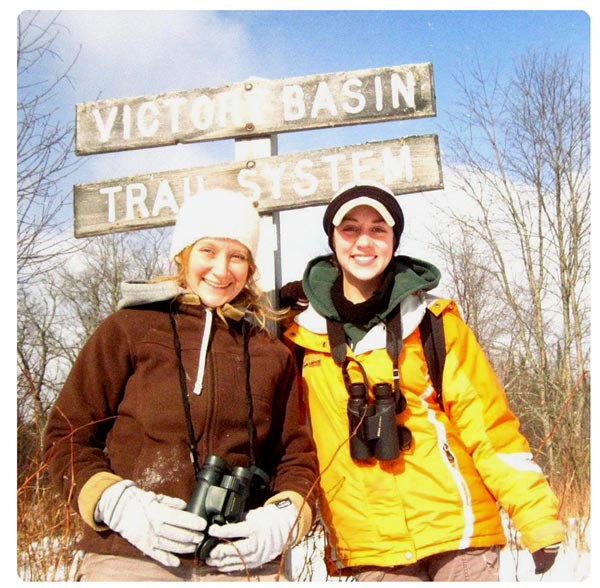There’s not much I’d rather do during my treasured weekend hours than make my way through some stretch of woods, just to see what I can see. In the green and humid glory of a New England summer day, a walk through the forest can be a balancing act: trying to keep my eyes upward to the tree branches for a flash of warbler yellow, while glancing downward in an effort not to miss forget-me-not blue.
In the winter, well, it’s different. In winter, things are plain out in the open. Everything is sharper: brittle trees, white ground, ice-cold air up the nose. The balancing act is literal as we try not to fall on icy paths and slippery porch stairs. In winter, we face the music; there are no shadows to linger in, no summer light to carry us through the evenings. It’s dark around 5 p.m., and it’s cold. And you better like it or you’re out of luck around here.
But despite its sharp edges, winter brings certain gifts unavailable at different times of the year. In the season’s plain landscape, the ordinary can become extraordinary. You notice things that were obscured by summer’s gaudiness. Simple pleasures – a walk with a friend, a warm cup of liquid in cold hands, the glimpse of a rare bird flitting through a black spruce swamp – become that much sweeter.
Last weekend, my good friend Sara and I donned our long johns, packed up our binoculars and cameras, and headed a few hours north to Victory Basin in Victory, Vermont – a nearly 5,000-acre patch of boreal forest complete with a tamarack bog and the allure of northern bird species. A self-proclaimed bird nerd, Sara is just the gal I want by my side as I head into the woods in search of avian life. She’s an excellent birder, someone who takes the time to notice the littlest details in nature, and has a wicked sense of humor.
As we began our trek in, we were immediately greeted by a lone snow bunting flying from the trail entrance, then a din of bird activity in a cluster of spruce trees. Black-capped chickadees and pine siskins chattered above us, and we “pished” them in to get a closer look. Red- and white-breasted nuthatches pitched disgruntled nasal beeps toward us as they took in our arrival, and a downy woodpecker gave us an angry squeak. We plodded on through the woods, visited repeatedly by charms of siskins, always with chickadees and American goldfinches in tow. We admired the bare tamaracks, took long whiffs of crushed cedar in our hands, and photographed highbush cranberries glowing in the sunlight. We laughed at the tightrope-like tracks of ruffed grouse: one tiny foot directly in front of the other, and stalked woodpeckers upon hearing their knocks.
Hours passed. We talked and laughed and walked in quiet, and when we finally decided to turn back, we lamented the fact that none of the boreal species we had hoped to see – gray jays, boreal chickadees, and the like – made an appearance. We talked about where we might go on our next road trip: further north? Or to the coast? And as always, our talk turned to spring and we soon found ourselves pining for the return of red-winged blackbirds and trout lilies.
As we walked on back toward the trailhead, Sara stopped short and grabbed my arm. “Chut-chut-chut-chut!” went a bird. “Meghan,” Sara said, still holding my arm, “that’s a crossbill!” The bird continued to call, and we waited for him to show movement. We scanned the trees around us, looking for the flap of a wing. Minutes passed and the call faded, but then came back and doubled. Two crossbills. And finally we saw them. White-winged crossbills flew from the top of one spruce to the next. We trained our ‘nocs on them, and saw that there was a pair – a male and female – flying about.
“I’m crying,” Sara said as she laughed, tears rolling down her cheeks.
For some birders, seeing a “lifer” (a species you have not seen before) can be an emotional moment. I remember seeing the odd eating habits of crossbills in David Attenborough’s Life of Birds series and thinking to myself, “Will I ever see that whacky bird?” And here they were, right in front of us in the blazing sun at Victory Basin.
Soon, another pair of white-winged crossbills moved in to see what all the chit-chat was about (no doubt the birds were calling and flying about in response to Sara’s and my presence). One of the females had nesting materials in her mouth. These finches breed year-round if food is available – pretty amazing for such a small bird inhabiting northern territory. More amazing? The lower mandible of crossbills is angled toward one side. These birds feed primarily on the seeds found in the cones of various coniferous trees. They use their oddly-angled beaks to pry open the scales of the cone, while their tongue licks out the seed.
There are hundreds of species of birds Sara and I have yet to see, and we have high hopes of seeing more lifers each year. But birding is not just about checking rare birds off one’s life list. As Sara and I neared the trailhead from where we started, another chittering, buzzing flock of siskins and chickadees was upon us, and we stopped and looked. “I just don’t get tired of this,” Sara said.
If we hadn’t seen crossbills, would the 2-hour drive to Victory have been worth it, just to see chickadees and siskins? Yeah, it would have been. The familiar can be divine if we take a closer look. And a black-capped chickadee hanging upside-down from a tree branch is nothing to pass by.



Discussion *